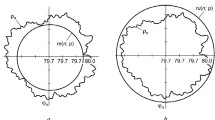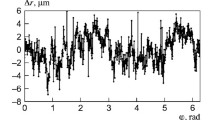The article discusses the acute production issue of reducing the error in measuring the roundness of rolling bearings parts. The scientific rationale for the selection of reference circles in the analysis of the roundness of the specified parts is presented. The selection criteria were physical interpretability, minimum roundness, reliability and performance of the roundness calculation algorithm. The inner and outer surfaces of the rings and balls of a single-row radial bearing have been measured on a roundness gauge and a coordinate measuring machine. The roundness values of bearings parts were calculated using four reference circles: least squares, minimum zone, minimum circumscribed, maximum inscribed. It has been found that the calculation along the minimum zone circle provides the minimum roundness value. Statistical Monte-Carlo modelling has been carried out to assess the distribution of parts roundness in a batch of bearings. For this purpose, a technique has been developed that allows, on the basis of harmonic analysis, identifying the distribution parameters of amplitudes and initial phases of harmonics of the parts profile, and then modelling the distribution in the batch, taking into account the correlation. The results of statistical modelling have confirmed that the minimum zone circle has the minimum roundness value in terms of arithmetic mean and standard deviation. A reliable and high-performance numerical algorithm for minimizing the functional in the form of the minimum zone width has been applied to calculate the centre of the minimum zone circle. The calculation along the minimum zone circle for the outer and inner rings of the bearing made it possible to minimize the gap between them. Taking into account all the criteria, it is recommended to use the minimum zone circle for the analysis of roundness of the rings and balls of rolling bearings.

Similar content being viewed by others
References
D. J. Whitehouse, Handbook of Surface and Nanometrology, CRC Press/Taylor & Francis Group, Boca Raton (2010), 2nd ed.
O. V. Zakharov and A. V. Kochetkov, “Minimization of the systematic error in centreless measurement of the roundness of parts,” Metrologiya, No. 4, 20–28 (2015).
O. V. Zakharov and B. M. Brzhozovskii, “Accuracy of centering during measurement by roundness gauges,” Izmer. Tekhn., No. 11, 20–22 (2006).
F. V. Grechnikov, A. F. Rezchikov, and O. V. Zakharov, “Iterative method of adjusting the radius of the spherical probe of mobile coordinate-measuring machines when monitoring a rotation surface,” Izmer. Tekhn., No. 4, 21–24 (2018), https://doi.org/10.32446/0368-1025it.2018-4-21-24.
S. Mekid and K. Vacharanukul, “In-process out-of-roundness measurement probe for turned workpieces,” Measurement, 44, No. 4, 762–766 (2011), https://doi.org/https://doi.org/10.1016/j.measurement.2011.01.011.
Y. Zhou, Q. Li, L. Chu, et al., “A measurement system based on internal cooperation of cameras in binocular vision,” Meas. Sci. Technol., 31, No. 6, 065002 (2020), https://doi.org/https://doi.org/10.1088/1361-6501/ab6ecd.
O. A. Zayakin, A. V. Manukhin, and A. A. Rostov, “Pilot laser roundness meter, research for the main measurement error,” Izv. Samarsk. Nauch. Tsent. RAN, No. 6, 184–188 (2017).
O. V. Zakharov, I. N. Bobrovskij, and A. V. Kochetkov, “Analysis of methods for estimation of machine workpiece roundness,” Procedia Eng., 150, 963–968 (2016), https://doi.org/https://doi.org/10.1016/j.proeng.2016.07.071.
V. A. Pechenin, M. A. Bolotov, N. V. Ruzanov,et al., “Mating of components with conical surfaces,” STIN, No. 3, 28–33 (2017).
J. Stone, B. Muralikrishnan, and C. Sahay, “Geometric effects when measuring small holes with micro contact probes,” J. Res. Nat. Inst. Stand. Technol., 116, No. 2, 573–587 (2011), http://dx.doi.org/https://doi.org/10.6028/jres.116.006.
Y. L. Chen, Y. Machida, Y. Shimizu, et al., “A stitching linear-scan method for roundness measurement of small cylinders,” CIRP Ann., 67, 535–538 (2018), https://doi.org/https://doi.org/10.1016/j.cirp.2018.04.009.
A. V. Khurtasenko, I. V. Shrubchenko, and S. P. Timofeev, “Method for determining the shape of the outer rolling surface of the technological drum supports,” Vestn. BGTU Shukhova, No. 3, 85–89 (2015).
L. Chybowski, K. Nozdrzykowski, Z. Grzadziel, et al., “Method to increase the accuracy of large crankshaft geometry measurements using counterweights to minimize elastic deformations,” Appl. Sci., 10, No. 14, 4722 (2020), https://doi.org/https://doi.org/10.3390/app10144722.
I. A. Grachev, M. A. Bolotov, V. A. Pechenin, and E. V. Kudashev, “Comparative analysis of simulation options for the real geometry of the surfaces of gas turbine engine parts,” J. Phys.: Conf. Ser., 1745, 012087 (2021), https://doi.org/https://doi.org/10.1088/1742-6596/1745/1/012087.
C. Zhi-Min, W. Yun, and H. Jian, “Roundness deviation evaluation method based on statistical analysis of local least square circles,” Meas. Sci. Technol., 28, 105017 (2017), https://doi.org/https://doi.org/10.1088/1361-6501/aa770f.
Y. Liu, Z. Wu, T. Xie, and Y. Xu, “Development of the control system in bearing roundness measuring instrument based on CPAC,” Proc. 7th Int. Conf. on Education, Management, Computer and Society, Advances in Computer Science Research (EMCS 2017), ACSR (2017), Vol. 61, pp. 396–402, https://doi.org/https://doi.org/10.2991/emcs-17.2017.78.
R. Viitala, G. Gruber, B. Hemming, et al., “Device and method for measuring thickness variation of large roller element bearing rings,” Precis. Eng., 55, 59–69 (2019), https://doi.org/https://doi.org/10.1016/j.precisioneng.2018.08.007.
R. Viitala, T. Widmaier, B. Hemming, et al., “Uncertainty analysis of phase and amplitude of harmonic components of bearing inner ring four-point roundness measurement,” Precis. Eng., 54, 118–130 (2018), https://doi.org/https://doi.org/10.1016/j.precisioneng.2018.05.008.
B. N. Markov, O. N. Melikova, and S. E. Ped’, “Development of algorithms and programs for construction of reference circles for the analysis of deviations from roundness,” Izmer. Tekhn., No. 2, 35–38 (2019), https://doi.org/10.32446/0368-1025it.2019-2-35-38.
G. I. Sheveleva, Theory of Forming and Contact of Moving Bodies, Stankin, Moscow (1999).
A. A. Nikolskii and V. V. Korolev, “Precision method of measurement of the form of cross-sections of complex profile on an out-of-round gauge without preliminary centering,” Izmer. Tekhn., No. 6, 24–29 (2011).
S. Shi, R. Kuschmierz, G. Zhang, et al., “Modeling, quantification, and mitigation of uncertainty propagation in twostep roundness measurements,” Measurement, 155, 107530 (2020), https://doi.org/https://doi.org/10.1016/j.measurement.2020.107530.
S. Adamczak, K. Stepien, and U. Kmiecik-Soltysiak, “A concept of an application of couples comparing method to the comparison of roundness profiles,” Procedia Eng., 192, 4–9 (2017), https://doi.org/https://doi.org/10.1016/j.proeng.2017.06.001.
P. Yu. Bochkarev, O. V. Zakharov, V. V. Shalunov, and E. P. Reshetnikova, Certificate of State Registration of Computer Software No. 2014612744, “Calculation of deviations from roundness of parts,” publ. March 6, 2014.
A. Rossi and M. Lanzetta, “Roundness: A closed form upper bound for the centroid to minimum zone center distance by worst-case analysis,” Measurement, 46, 2251–2258 (2013), https://doi.org/https://doi.org/10.1016/j.measurement.2013.03.025.
R. Calvo and E. Gómez, “Accurate evaluation of functional roundness from point coordinates,” Measurement, 73, 211–225 (2015), https://doi.org/https://doi.org/10.1016/j.measurement.2015.04.009.
N. Megiddo, “Linear-time algorithms for linear programming in $R^3 $ and related problems,” SIAM J. Comput., 12, No. 4, 759–776 (1983), https://doi.org/https://doi.org/10.1137/0212052.
X. Li, H. Zhu, Z. Guo, and Y. Liu, “Simple and efficient algorithm for the roundness error from polar coordinate measurement data,” Rev. Sci. Instrum., 91, 025105 (2020), https://doi.org/https://doi.org/10.1063/1.5141146.
F. Liu, G. Xu, L. Liang, et al., “Minimum circumscribed circle and maximum inscribed circle of roundness deviation evaluation with intersecting chord method,” IEEE T. Instrum. Meas., 65, No. 12, 2787–2796 (2016), https://doi.org/https://doi.org/10.1109/TIM.2016.2601003.
I. D. Gebel, “Selecting a base circumference for the profile shape of a solid of revolution,” Izmer. Tekhn., No. 10, 20–24 (1971).
Author information
Authors and Affiliations
Corresponding author
Additional information
Translated from Izmeritel’naya Tekhnika, No. 2, pp. 14–21, February, 2022.
Rights and permissions
Springer Nature or its licensor holds exclusive rights to this article under a publishing agreement with the author(s) or other rightsholder(s); author self-archiving of the accepted manuscript version of this article is solely governed by the terms of such publishing agreement and applicable law.
About this article
Cite this article
Zakharov, O.V., Pugin, K.G. Selection of Reference Circles in the Analysis of Roundness of Rolling Bearings Parts. Meas Tech 65, 96–103 (2022). https://doi.org/10.1007/s11018-022-02055-y
Received:
Accepted:
Published:
Issue Date:
DOI: https://doi.org/10.1007/s11018-022-02055-y




